And some of the most important ones live in the form of these Ideas Worth Borrowing.
The seven teams that brought these Ideas Worth Borrowing to life vary in size, location, job scope, and resources. Their commonality is that they took an entrepreneurial approach to an opportunity and embraced technology to make new and noteworthy things happen.
A few of these IWBs are for your whole team. Some are for your boss. Others are for just you. In every case, they will help your advancement shop run better so that you can change more students’ lives.
These are Ideas Worth Borrowing, Full-Funnel Style.
Jump ahead to the videos:
KSU fundraisers make amazing videos
Louisiana Tech uses Giving Day to find new prospects
West Point found 112 new CEOs and Presidents
University of Miami discovered 7,000 new major gift prospects
OSU retrained their gift officers
Wisconsin sent personalized videos to every donor
Full-Funnel Overview
We all know about the Giving Pyramid. The “pyramid” model has been a really important way to establish our targets for capital campaigns and organize our work. But, with the growth of digital engagement online and offline and the ability to marry that data to traditional donor profiles, it’s presented an opportunity to create an integrated funnel.
At EverTrue, we’ve been talking about this integrated donor funnel for a while. The Giving Funnel is an approach to advancement based on the for-profit world’s sales funnel. It gives organizations a framework for how to engage people and qualify leads, assign those prospects for personalized outreach, solicit a gift, and grow your donor base by retaining their support. This model is the future of fundraising.
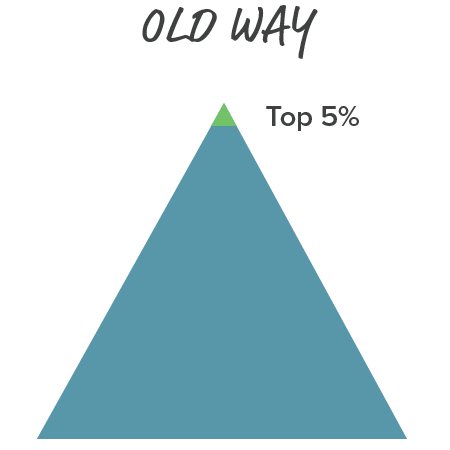
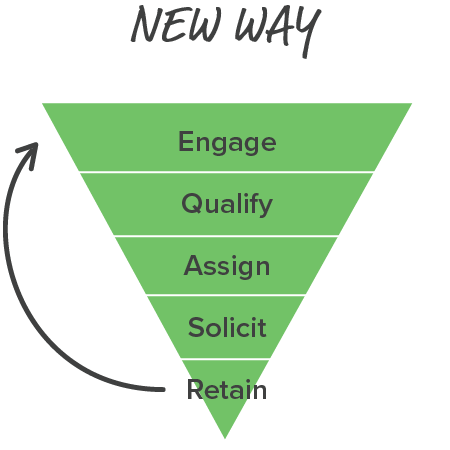
Let’s start at the top of the funnel and work through seven advancement teams across the country who are embracing technology and bringing full-funnel wins to their institutions.
Engagement
Between our email inboxes, social media profiles, buzzing phones, and myriad screens, we know all too well: there is only so much mindshare to be had.
Let’s just consider the content that is coming from your institution. Your student athletes are churning out Instagram reels. Your Dean’s Scholars are making TikTok videos. Your professors are featured on the evening news.
What content is the advancement office producing?
If you want to really be a contender in the fight for mindshare, your content arsenal has to be more creative and engaging than fiscal year end appeals or a “P.S.” link to a professor’s recently published book.
Put yourself in your alums’ shoes. What content would YOU want to consume? What link would YOU click on? Which email would YOU open?
This:
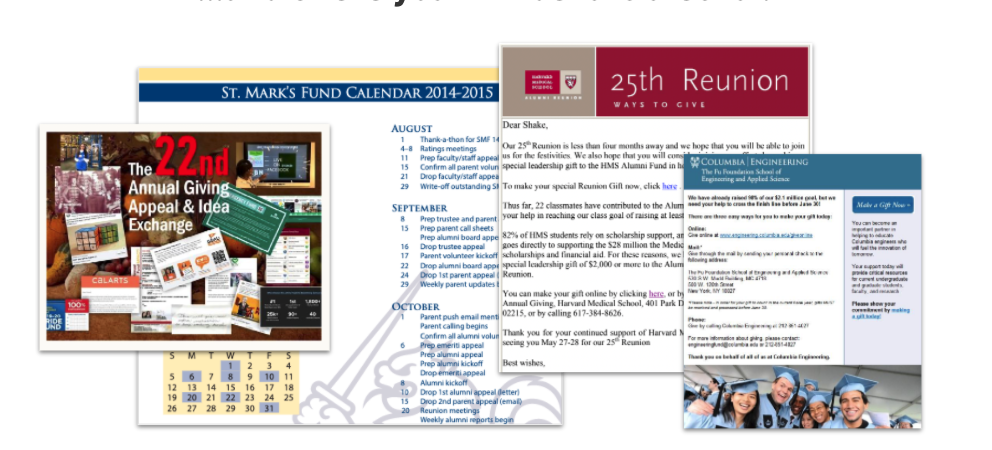
Can’t compete with this:
Mary Bourne and the Kansas State University team have been contenders in the fight for the mindshare of their alums for a while now. (Check out this pre-COVID story about the “magic backpacks” they built so that their gift officers could all contribute authentic videos to the KSU content machine. So cool.)
For their giving day in 2020, KSU went all-in to fund Textbooks 2.0, the university’s Open/Alternative Textbook Initiative to make a KSU education more accessible through reducing the cost of required books.
To raise awareness for Textbooks 2.0, KSU launched #MartyOnTheStreet.
It was creative. It was fun. It was authentic, home-grown, and home-produced. (All true to the K-State way.)
When so many advancement shops around the country canceled their days of giving, Marty on the Street helped KSU keep and build momentum towards their All-In Day of Giving.
In the end they broke all previous Giving Day records. AND, they created a content following and brand recognition that carried them through COVID with the “Marty Minute.”
Who is your Marty? What fun, authentic video content can you create for your alums? How are you going to get in the fight for mindshare and show your alums that they’re worthy of receiving creative, engaging content, too?
Qualification
So, let’s say you’re producing amazing content. You’re meeting your alums where they’re already at (online) through a medium that captures their attention (video). And thousands of unmanaged, high-net-worth alums are engaging with your content.
Now, what?
Devin Ferguson at Louisiana Tech demonstrates how simple it is to dig in and identify the digitally-engaged, high-potential prospects that are hidden in plain sight.
Devin and his team wanted to find out what content inspired alums to give on LA Tech’s second annual Giving Day. Using EverTrue, he looked at who had engaged with LA Tech on Facebook in the 30 days leading up to Giving Day. It was 725 folks. 135 of them made gifts on Giving Day. (Once again, it’s proven that digital engagement leads to giving.)
Devin and team drilled down a little further. They wanted to know which prospects assigned to an MGO or DXO portfolio gave a gift on Giving Day.
It was 650 folks. They directed MGOs to send immediate, personalized “thank yous” to those 650 assigned prospects. Boom.
Devin’s team also identified 66 prospects who had engaged on Facebook, who made a gift on Giving Day, had a high net worth (net liquid assets over $1M), but were unassigned.
With a few clicks in EverTrue, Devin and team were able to put 66 new prospects onto MGO radars and boost MGO activity by generating timely, personalized touchpoints with over 650 prospects.
Do you know when prospects in your portfolio change jobs? Do you know when unassigned alums land a VP+ position or a role in the C-Suite?
You should. You can. West Point Association of Graduates does.
WPAOG was an early partner using Career Moves — EverTrue’s human-verified career updates. We deliver data as alumni change jobs, continually keeping career information fresh and prompting teams to reach out to their graduates at key points in their lives.

In six months, West Point tracked 2100+ job changes through EverTrue Career Moves. They exported the data and updated their database, including LinkedIn urls. They notified gift officers or new C-suite job titles or folks with confirmed net worth over $1MM. They updated ratings for 112 likely prospects and CEOs/presidents. And they added 39 new prospects to portfolios.
Intrigued? View more here.
Assignment
“No longer do we want to just say ‘we have a million followers.’ Now, it’s what do we do with those followers.”
Brittany Shaff ran the University of Miami’s Digital Engagement and Philanthropic Giving team (she just recently joined the stellar Graduway team). At the U, Brittany led her team to view social engagement from alums as a two-way street.
When alums engage with your school’s content on social media, they’re raising their hands to show that they care. So, in turn, you should show them that you care, too!
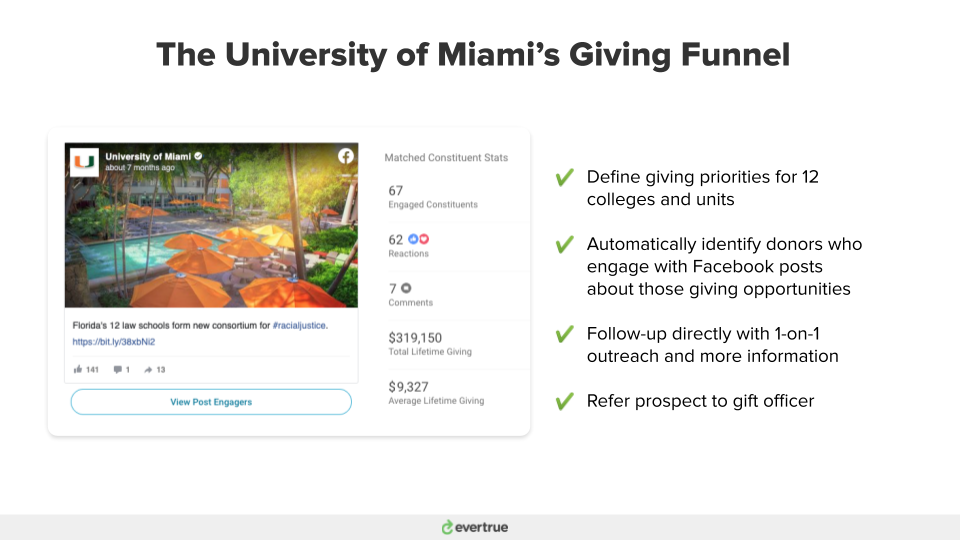
When UMiami alums engaged with one of the school’s a social post, Brittany and her team paid attention. They looked at the interactions. They followed up within 48 hours with relevant content via a personal email. They noted who opened or responded to the email, and they referred those “warm leads” to gift officers.
They didn’t miss a chance to turn those digital engagers into heightened engagers, givers, or both.
This is the Giving Funnel in action at the University of Miami:
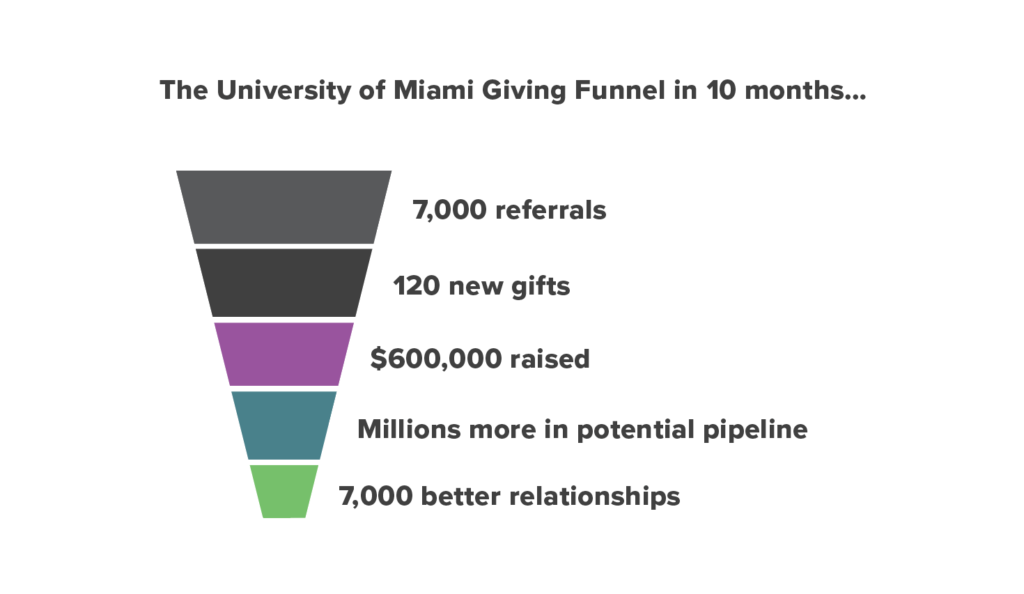
Read the full funnel story here, which includes the EverTrue searches the U Miami team uses to keep track of digital engagers.
Solicitation
Oregon State University launched the nation’s first DXO program in January of 2020. The DXOs had such high activity, donor retention, and new revenue that OSU leadership tasked Anne Murphy with training her team of Assistant Directors of Development in the DX approach.
Changing personal habits is hard. Changing a whole team’s habits is, well… really, really hard.
Anne started by admitting that the “old way” of fundraising (spreadsheets, call logs, sticky notes, clunky databases) wasn’t working very well. Even with the very best of intentions, prospects fell through the cracks.
And she started with herself. She trained in a whole new suite of technology. She used EverTrue to keep track of her portfolio and give her snapshots of prospects’ engagement, career information, and wealth indicators. She embraced DX outreach cadences to build a thoughtful, 12-step rhythm of outreach to donors.
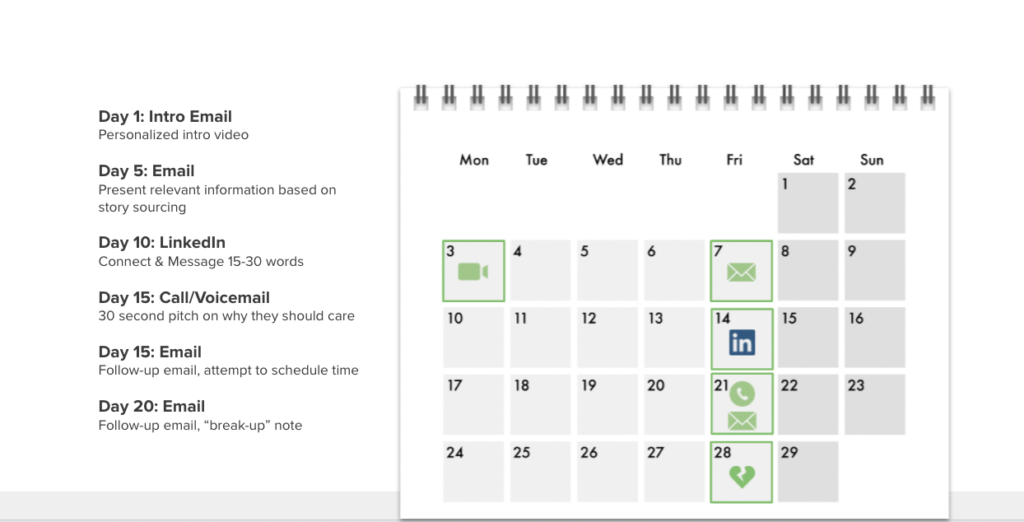
Have you ever tried to convince someone to break a habit and embrace a better way to do things? If so, then you’ve learned that the best way to convince others to get on board with a good idea is to demonstrate yourself that it works.
Anne identified two new estate gifts in the first month of DX outreach. She held more meetings, closed gifts, built new relationships, and brought in more cash. She even had an “oops!” that turned into an “awesome!”
So, her team was sold. And they’re seeing amazing results after a few months of changing their ways.
Retention
When you buy a product or service, you typically receive a personalized thank-you email, and you also receive an actual something that you can consume.
But in the for-profit world, the transaction usually isn’t the final step. The company capitalizes on the opportunity to celebrate your purchase and in a short period of time, they follow up to ask if you like your new item or service, and to remind you of similar products that you might like.
You receive this kind of treatment as a customer because it is significantly less expensive for a company to retain an existing customer than to sign a new one. Healthy for-profit companies operate at a 90%+ customer retention rate. And yet, in higher-ed fundraising, donor retention rates are low (often below 70%) and aren’t consistently included in a team’s most-watched metrics.
But donor retention is so, so important. And personalization and timeliness are two key elements to keeping your donors in the inner circle.
Last summer, the University of Wisconsin sent personalized videos to every single one of the donors who contributed since the start of the pandemic. (Like, the true type of personalization in which students greeted the alum by first name).
Aimee Furrie is UW’s Stewardship Program Manager. In her words, “People were feeling a lack of human connection and we wanted to provide them with that and remind them that we’re all part of this community. Everything went digital and living rooms became recording studios. TV commercials, American Idol, and late-night TV — viewers were transported into people’s homes with a perspective we’d never had before. So why couldn’t UW do the same thing?”
So, personalized thank you videos were created for 35,000 donors and sent from 7 students. That’s right. Just seven. (We know you must work with at least seven students through your work-study or phonathon program).
They did a whole lot with a lean team, and they found ways to work smarter. For example, they grouped videos by first name. So, one student recorded a video that went to everyone named “Ahmad.” Another recorded to everyone named “Brian.”
Here are the results of UW’s videos:
- 35,000 videos sent via ThankView
- Open rate over 50%
- 11,365 video views
- 400+ email replies
- More than 200 leads on new major gift prospects as the Wisconsin research team looked into the most engaged viewers
- Received new gifts from over 50% of the alums who viewed the students’ videos. That’s incredible ROI!
(We know that some folks in higher ed advancement feel that personalization takes too much time to do it in a scalable way that grows the donor base. If you feel this way, you simply don’t have the right tech at your fingertips. So it’s not you, it’s us. For real. Reach out.)
Institutions like Bentley University are enacting similar retention moves. When Bentley University received more than 1,000 career updates, they put that information into action immediately, sending a congratulatory note to every alumni who took on a new job or promotion.
That email had a 60% open rate (roughly 3x’s the industry average), generated dozens of responses, and was even shared by happy graduates on Instagram.
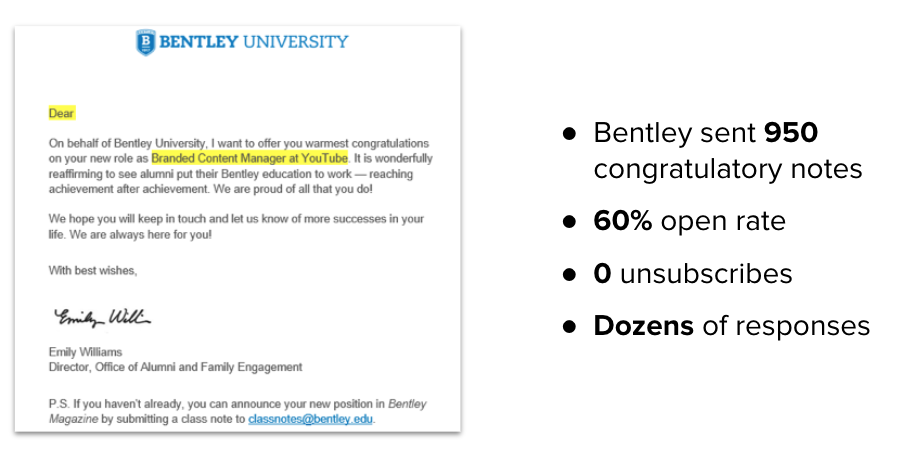
Louisiana Tech came through with another retention win. Using EverTrue Career Moves, they monitored job changes and sent personalized “congrats” videos to their alums who had just made moves.
Check out this response from a recent Louisiana Tech graduate who landed a job at Cintas and received a personalized congratulations from the Director of Alumni Engagement.
Stewarding your donors takes so much more than a thank-you. It is the well-deserved soft place to land immediately after a gift is made, but it is also the conduit to a closer, more meaningful connection between donor and institution. It is the chance to form a connection so strong that your donors feel they are an integral member of your inner circle (because they are). Personalized, timely stewardship ensures that they won’t want to leave.
Go forth!
Now you have seven new, actionable IWB’s to fuel high-level discussions with university leadership, to inspire your team to think bigger, and to incorporate into your own work flows starting, well, now.
And if do “B” one of these IWBs, let us know. We’d love to hear about it.
